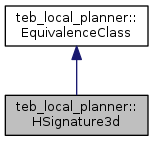The H-signature in three dimensions (here: x-y-t) defines an equivalence relation based on homology using theorems from electro magnetism. More...
#include <h_signature.h>

Public Member Functions | |
| template<typename BidirIter , typename Fun > | |
| void | calculateHSignature (BidirIter path_start, BidirIter path_end, Fun fun_cplx_point, const ObstContainer *obstacles, boost::optional< TimeDiffSequence::iterator > timediff_start, boost::optional< TimeDiffSequence::iterator > timediff_end) |
| Calculate the H-Signature of a path. More... | |
| HSignature3d (const TebConfig &cfg) | |
| Constructor accepting a TebConfig. More... | |
| virtual bool | isEqual (const EquivalenceClass &other) const |
| Check if two candidate classes are equivalent. More... | |
| virtual bool | isReasonable () const |
| Check if the trajectory is non-looping around any obstacle. Values greater than 1 indicate a looping trajectory. More... | |
| virtual bool | isValid () const |
| Check if the equivalence value is detected correctly. More... | |
| const std::vector< double > & | values () const |
| Get the current h-signature (read-only) More... | |
 Public Member Functions inherited from teb_local_planner::EquivalenceClass Public Member Functions inherited from teb_local_planner::EquivalenceClass | |
| EquivalenceClass () | |
| Default constructor. More... | |
| virtual | ~EquivalenceClass () |
| virtual destructor More... | |
Private Attributes | |
| const TebConfig * | cfg_ |
| std::vector< double > | hsignature3d_ |
Detailed Description
The H-signature in three dimensions (here: x-y-t) defines an equivalence relation based on homology using theorems from electro magnetism.
The H-Signature depends on the obstacle configuration and can be utilized to check whether two trajectores belong to the same homology class. Refer to:
- S. Bhattacharya et al.: Identification and Representation of Homotopy Classes of Trajectories for Search-based Path Planning in 3D, 2011
Definition at line 254 of file h_signature.h.
Constructor & Destructor Documentation
|
inline |
Constructor accepting a TebConfig.
- Parameters
-
cfg TebConfig storing some user configuration options
Definition at line 261 of file h_signature.h.
Member Function Documentation
|
inline |
Calculate the H-Signature of a path.
The implemented function accepts generic path descriptions that are restricted to the following structure:
The path is composed of points T and is represented by a std::vector< T > or similar type (std::list, std::deque, ...).
Provide a unary function with the following signature std::complex< long double > (const T& point_type) that returns a complex value for the position (Re(*)=x, Im(*)=y).
T could also be a pointer type, if the passed function also accepts a const T* point_Type.
- Parameters
-
path_start Iterator to the first element in the path path_end Iterator to the last element in the path obstacles obstacle container fun_cplx_point function accepting the dereference iterator type and that returns the position as complex number.
- Template Parameters
-
BidirIter Bidirectional iterator type Fun function of the form std::complex< long double > (const T& point_type)
Definition at line 282 of file h_signature.h.
|
inlinevirtual |
Check if two candidate classes are equivalent.
If the absolute value of the H-Signature is equal or greater than 1, a loop (in x-y) around the obstacle is indicated. Positive H-Signature: Obstacle lies on the left hand side of the planned trajectory Negative H-Signature: Obstacle lies on the right hand side of the planned trajectory H-Signature equals zero: Obstacle lies in infinity, has no influence on trajectory
- Parameters
-
other The other equivalence class to test with
Implements teb_local_planner::EquivalenceClass.
Definition at line 358 of file h_signature.h.
|
inlinevirtual |
Check if the trajectory is non-looping around any obstacle. Values greater than 1 indicate a looping trajectory.
- Returns
- Returns false, if the trajectory loops around an obstacle
Implements teb_local_planner::EquivalenceClass.
Definition at line 402 of file h_signature.h.
|
inlinevirtual |
Check if the equivalence value is detected correctly.
- Returns
- Returns false, if the equivalence class detection failed, e.g. if nan- or inf values occur.
Implements teb_local_planner::EquivalenceClass.
Definition at line 388 of file h_signature.h.
|
inline |
Get the current h-signature (read-only)
- Returns
- h-signature in complex-number format
Definition at line 416 of file h_signature.h.
Member Data Documentation
|
private |
Definition at line 419 of file h_signature.h.
|
private |
Definition at line 420 of file h_signature.h.
The documentation for this class was generated from the following file: